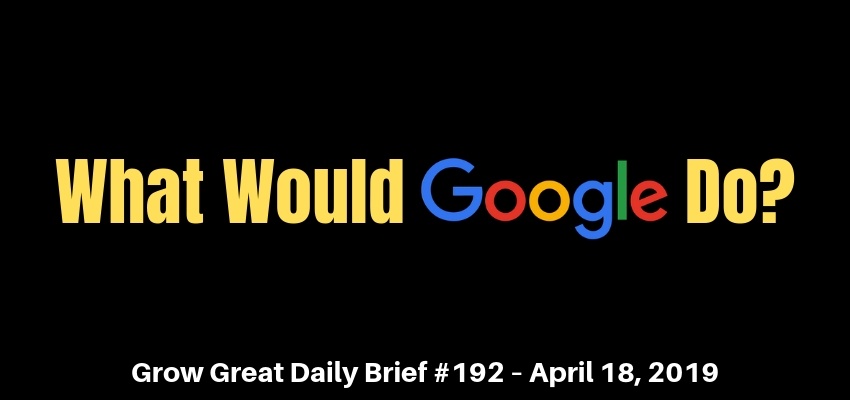Podcast: Play in new window | Download (Duration: 10:50 — 12.9MB)
Subscribe: Apple Podcasts | Spotify | RSS | More
On Tuesday Inc. magazine published an article by columnist Betsy Mikel (I’m a fan of her work) about what Google discovered about high achieving teams. Google’s manager of the People Innovation Lab conducted a 2-year study involving 5,600 Google employees. She also conducted focus groups with about 100 employees. On April 4, 2019 Veronica Gilrane, the manager, published her findings on the Google blog.
The study discovered 3 specific things that tight-knit, productive teams do differently. I’m curious what you think about their findings.
First, they allow and even encourage mindless chit chat.
What with open office concepts where workers don headphones, and increasingly remote workers…there are fewer and fewer spontaneous conversations. When you don’t have chance encounters with co-workers you have fewer opportunities to get to know each other.
Many organizations have meeting intensive cultures. Leaders may think it best to hit the ground running in the meeting by jumping straight into the agenda. It’s easy to think you’ll be considerate of everybody’s time by diving directly into the hard business at hand. The problem is that sometimes we’re pushing for productivity when the team needs time to bond. A few beginning minutes spent answering the question, “What did you do this weekend?” can foster a deeper understanding among teammates. It helps employees see each other as people and not merely co-workers.
It can be helpful to arrive early to the meeting (whether it’s an in-person or virtual) so time can be spent in idle chit chat. Turns out, that chit chat isn’t so idle. It builds relationships.
Second, they switch up the time for recurring meetings.
At Google 30% of their meetings involve teammates in two or more time zones. That means some team members may be staying late at work, while others are getting up very early. If your team is spread out it’s impossible to find meeting times that conveniently accommodate everybody. Rather than impose on the same people’s schedule each time, mix things up and let everybody take a turn at staying late or getting up early.
Quite simply, this is an act of kindness and consideration. If you don’t manage remote teams, you can likely leverage this tactic by implementing those qualities in your work environment. Nothing trumps kindness and consideration.
Third, Google discovered that in video meetings it’s important for members to use their words and their face.
Video conferencing platforms are very good these days (and continuing to get better). Most of us understand the value of muting our microphones when we’re not talking. The problem is people don’t always know if we’re engaged or not. We can be on video calls and notice people are doing other things. It makes for unengaged conversation.
Pay attention to how you show up on the call. Subtle behaviors like nodding, uncrossing your arms, having your webcam set at eye level…these can drastically improve the experience. And verbal validation helps, too. Think of how you feel when you’re on a video call and somebody says, “Sounds like a good idea.”
Be attentive. Be present. Google even has a Distributed Work Playbook. (click that link and you can download the PDF)
I’ll also give a shout out to the kids over at Basecamp who wrote a book entitled, REMOTE: Office Not Required. It’s another great resource if you’re considering a remote workforce.
What I like about this Google study is the practical “this is what we do” nature of it. Scholars and academians enjoy complicating things. Google proves that execution is practical. Easy? Not necessarily, but doable if leadership will lead and if people will understand where and how they fit in the business.
 Things have changed dramatically over the past 10 years at Google, but in 2009 Jeff Jarvis wrote a nice book entitled, “What Would Google Do?”
Things have changed dramatically over the past 10 years at Google, but in 2009 Jeff Jarvis wrote a nice book entitled, “What Would Google Do?”
Jarvis chronicles 40 rules employed at Google. Some are counter-intuitive. Others innovative. It’s worth reading to escape whatever box may contain your current thinking.
I’m not urging you to ask that question so you can make direct application to your business. Let’s face it, you’re not Google, but looking at a behemoth manage 10,000 employees spread across 150 cities is bound to have value.
The broader lesson may be the value derived from outside perspectives. We’re all steeped in our own industries. We read the same trade material, admire those who are at the top of our field and largely…we’re drawn to follow the leader. That leads to a lot of copycat behavior where innovation stagnates. It doesn’t foster bold courage to try something different – something that may just catapult us to a new height of achievement.
Be well. Do good. Grow great!
RC
